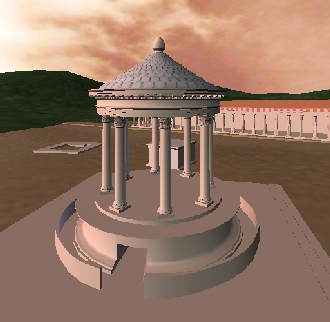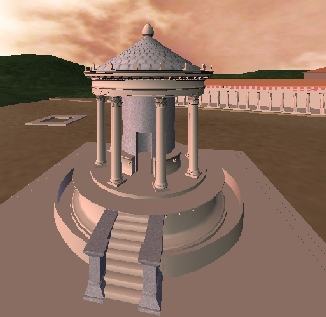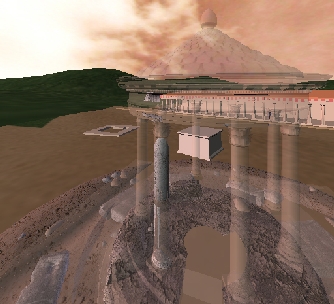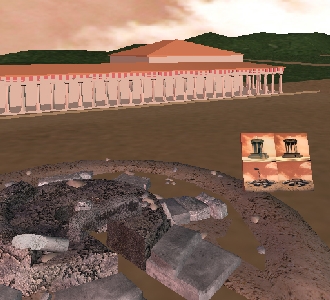Closing Day of the ARCHEOS Project: Dec 8th 2003
Final schedule of the ARCHEOS
meeting, 12/8/2003
at INRIA Sophia-Antipolis
(Presentations now online !)
9:30-9:45 Introduction + Welcome: George
Drettakis and Marc Berthod
9:45-10:15 Historical context: Isabelle
Ratinaud
10:15-10:30 Crowd animation: Joelle Thollot
(presentation)
10:30-11:00 Dynamic Canvas: Matthieu Cunzi (presentation) (Video of Results)
11:00-11:15 Break
11:15-11:45 Watercolor rendering and
animation: Pascal Barla (presentation)
11:45-12:00 NPR and Virtual Reality: George
Drettakis (presentation)
12:00-12:15 Conclusion: Isabelle Ratinaud
et Joelle Thollot (presentation)
12:15-12:45 Demos on the INRIA workbench:
George Drettakis
12:45-14:00 Lunch
14:00-15:30 Brainstorming on computer graphics/virtual reality (CG/VR)
and archaeology
- Question to computer scientists: "What is
a computer scientist in CG/VR able to do ? What do you think could be
useful for an archeologist ?"
- Question to archaeologists: "What would
you like to see in CG/VR for your work ?" What are your dreams in this
domain ?"
10mn talk and 5mn questions (in
alphabetical order and women first):
Computer scientisst:
Maria Roussou (presentation),
John Hughes (presentation),
Roberto Scopigno (presentation)
Archaeologists/Historians:
Isabelle Ratinaud,
Marcel Piérart
15:30-16:10 Break
16:10-17:20 Discussion: what kind of
research projects can we build on all the ideas previously developped ?
17:20-17:30 Summary of the discussion, end
of the meeting.
Activities of the ARCHEOS
Research
Initiative
Description of Work
Meetings/Discussions
CG Research Directions
Publications
Presentations
VR Experiences
Description of Work
The ARCHEOS research initiative set out to meet a number of goals.
The
first, and probably the most important goal was to establish a working
relationship between archeologists, historians and architects on the
one
side, and computer graphics/VR researchers on the other. The second
goal
was to investigate issues relating to rendering styles, and notably
non-photorealistic rendering, and in particular in relationship with
archeological applications. The context of this second goal was
concentrated in immersive or semi-immersive virtual reality systems,
such as the workbench at INRIA Sophia-Antipolis, or the RealityCenter
in
Grenoble.
A number of meetings and working groups (see next section), have taken
place in the context of the ARCHEOS research initiative, with
participants from different domains, establishing a core
multi-disciplinary group of researchers. The discussions concentrated
on
three main directions: (i) computer graphics (CG) research directions,
with an emphasis on non-photorealism and its application to archeology
and history, (ii) the importance of CG and Virtual Reality (VR) for
archeology and (iii) the development of Virtual Experiences to help
archeologists and historians in their work, for education and for
presentations to the general public.
In terms of the CG research, the main thrust of work was guided by
Joelle Thollot at the ARTIS research group of the GRAVIR Laboratory in
Grenoble, France. Details of this research are presented below; a
number
of publications have resulted, notably on the rendering of paper canvas
for walkthroughs, the simulation of emergent crowds and water-color
style renderings. Another direction included the implications of using
stereo for canvas representation, which is work in progress at
REVES/Inria Sophia-Antipolis.
A number of talks and a poster were presented at archeological forums
based on initial results of this work. The initial reaction of
archeologists has been very positive, and we believe that this work
will
foster further cross-disciplinary actions. The archeological work has
concentrated on the Argos project, which is the center of interest of
the ERGA group in
Grenoble, who participate in the project.
Finally, based on our multi-disciplinary discussions, at REVES/Inria
Sophia-Antipolis, we are designing VR experiences for educational and
archaeological research purposes.
Meetings/Discussions
To date, we have had seven meetings, all of which included
participants
from the various disciplines involved. Other than the July 2003 meeting
which concentrated mainly on CG research, allother meetings discussed
various aspects of the interaction between the disciplines involved. We
wish to highlight the meeting of September 2002 in Grenoble
(Monbonnot),
in which major archeologists of the Argos site (M. Pierart and A.
Pariente) discussed at length how these technologies can help their
work
after seeing interactive demos developed by ARCHEOS. For a detailed
list of the meetings and the participants, please see the Meetings
page.
CG Research Directions
Under the direction of Joelle Thollot, Matthieu Cunzi investigated
the
important issue of rendering canvas in the context of walkthroughs for
computer graphics, in the context of a DEA (2002). This resulted in a
publication at Graphics Interface 03 , with the collaboration of
G.
Debunne, S. Paris from ARTIS and F. Durand from MIT.
A second research direction involved the inclusion of crowds in
archeological non-photorealistic renderings. This work was pursued by
Laure Heigeas, under the supervision of Joelle Thollot and Annie
Luciani
in Grenoble during the academic year 2001-2002, resulting in a
publication at Graphicon 2003.
Under the direction of Joelle Thollot, Pascal Barla investigated issues
related to water color renderings in a DEA (MSc) at ARTIS in 2003.
Initial results have been presented in his DEA report.
At REVES INRIA Sophia-Antipolis, Roman Bayon did his engineering school
thesis work under the direction of George Drettakis. The goal was to
investigate the implications of stereo for various NPR algorithms, and
notably the canvas algorithm presented previously. This work is
currently in progress, and a first
report exists in French.
All of the above activities were funded in part by ARC ARCHEOS.
Publications

|
Dynamic
Canvas for Immersive Non-Photorealistic Walkthroughs
Mathieu Cunzi, Joëlle Thollot, Sylvain Paris, Gilles Debunne,
Jean-Dominique Gascuel, Frédo Durand
Proc. Graphics Interface 2003 2003
|


|

|
A
Physically-Based Particle Model of Emergent Crowd Behaviors
Laure
Heigeas, Annie Luciani, Joëlle Thollot, Nicolas Castagné
Graphicon 2003
|

|

|
Virtual
immersion in the ancient Greek city of Argos
Isabelle Ratinaud, Joëlle Thollot
International Congress of Classical Archaeology 2003
|
|

|
Développement
de techniques d affichage non-photoréalistes efficaces pour un
environnement de réalité virtuelle appliquée
à l archéologie
Roman Bayon
REVES/INRIA, Mémoire de Stage , august 2003
|

|
|
Rendu non-phoréaliste dans
le style aquarelle et en temps-réel pour des ballades virtuel,
Pascal Barla
Mémoire de DEA, July 2003
|
|
|
Photorealism and Non-Photorealism in Virtual Heritage Representation
Maria Roussou, George Drettakis
Submitted for Publication
|
|
Conferences and Presentations
I. Ratinaud and M. Cunzi will be presenting ARCHEOS at a
Symposium
on Argos to take place in Athens at the Ecole Francaise d'Athenes,
organized by Marcel Pierart.
I. Ratinaud presented work related to ARCHEOS at a seminar in
Fribourg in September 2003.
I. Ratinaud and J. Thollot presented their poster at the International
Conference of Classical Archeology 2003.
In the context of ARCHEOS, M. Cunzi and J. Thollot presented
their
paper at Graphics Interface'2003.
F. Letoublon organised a conferencein
Grenoble in november 2002, where the Argos project and some of
the results of ARCHEOS were presented.
G. Drettakis attended EGVE 2002 and P. Martinez SIGGRAPH 2003,
where
he presented virtual archeology work.
Some of these trips were partially funded by ARCHEOS.
VR Experience Construction
At REVES/INRIA Sophia-Antipolis we are in the process of building
two
VR experiences/demonstrators, based on our discussions with the
archeologists involved in the project.
The first demonstrator illustrates the two hypotheses for the Tholos
monument in the ancient Argos Agora. The images below are snapshots
from
the simulator which we have developed for these demos.

|

|
The Pierart
Hypothesis in the VR system
|
The Marchetti
hypothesis in the VR system
|

|

|
The reconstructed
Tholos is superimposed on the remains of today
|
The user can
manipulate the pieces interactively
|
The second demonstrator will show Argos through different eras,
geometric, classical and Roman (shown above).
GD 15/09/03






